This is the first of three postings devoted to a closer look at the shearwaters, petrels and storm petrels that we saw on our Hauraki Gulf pelagic trip on 3 December 2011 (see previous posting). It's the same sort of thing I did for the pelagic I took at Kaikoura in the South Island in March 2011 - the opportunities for photography on these things can be outstanding. The birds themselves are, overall, a quite different lot than the ones at Kaikoura - I saw no albatrosses on Hauraki Gulf, for example, and no storm petrels at Kaikoura. Two of the four species in this posting, however, did appear on both trips. The first is Buller's Shearwater (Puffinus bullerii).
Paradoxically, Buller's Shearwater - though it ranges, outside the breeding season, throughout much of the Pacific - can be regarded as a Hauraki Gulf specialty. As I noted in my previous post, the gulf is practically the only place in the world where it breeds.
Buller's is, to my eye, the most graceful and attractive of all shearwaters (or, at least, of the ones that I have seen).
Most field guides pick on the striking reverse "W" pattern on the upper surface of the wings as Buller's most distinctive field mark. You can see it clearly here.
The under surface of the wings, by contrast, are almost entirely pure white.
This one is checking below the surface, looking for the bits of food we have tossed out to lure it within reach.
Like all shearwaters, even the daintiest, Buller's needs a good running start over the water to become airborne.
So does this altogether more solid bird, the Flesh-footed Shearwater (Puffinus carniepes) - another species I saw both here and at Kaikoura.
The Flesh-footed is one of a number of confusingly all-dark petrels with more or less pale, dark-tilled bills. The giveaways, of course, are its pinkish-flesh legs.
The Flesh-footed's bill is quite pinkish, and comparatively long and slender, compared to the bills of the birds most likely to be confused with it in New Zealand - the petrels of the genus Procellaria. We'll be coming to one of them in a moment.
This can be useful when the bird is in flight, and its legs are not easy to see.
Like Buller's, the Flesh-footed Shearwater travels vast distances in the non-breeding season, reaching the Pacific coasts of Canada and the United States (where it is, however, much rarer than Buller's). Like so many other pelagic seabirds, it suffers from accidental drownings from longline fisheries, and my choke to death on floating plastic. Its numbers are in decline.
The Little Shearwater (Puffinus assimilis), smallest of the shearwaters, was a new species for me. Unfortunately, Little Shearwaters are not particularly interested in boats, even birding boats tossing delicious-looking fish guts over the side (they prefer smaller prey items such as krill). I had to be content with a few birds flying past at a distance - near enough, though, to see the species' most distinctive feature: the white of its face extends well above the eye.
This is probably the local breeding subspecies haurakiensis. Seabird taxonomy being what it is, there is a great deal of uncertainty about which of the various birds called "Little Shearwaters" around the world - particularly in the Atlantic - actually belong to this species. Some may end up as species in their own right, and others should perhaps be associated instead with another species, Audubon's Shearwater (Puffinus lherminieri). This subspecies, though, appears safely placed within the "true" Little Shearwaters, whatever they are.
Our fourth bird is not a shearwater but a petrel: the Parkinson's or Black Petrel (Procellaria parkinsoni), another new species for me (though I had seen the other two New Zealand Procellarias, the White-chinned and Westland Petrels (Procellaria aequinoctialis and westlandica) at Kaikoura and, on my first visit to New Zealand in 1974, found a carcass of a Parkinson's Petrel high on Little Barrier Island, one of its two known breeding grounds.
Parkinson's Petrel, like Buller's Shearwater, breeds nowhere else in the world but in Hauraki Gulf, on Great and Little Barrier Islands. There are only about 1400 breeding pairs, and Birdlife International ranks the species as Vulnerable.
We only saw a few birds. It looks very much like a Flesh-footed Shearwater, but has dark legs, appears more "bull-necked", and the pale areas of the bill are yellowish rather than pinkish.
It's an impressive, long-winged, solid-looking creature.
These two shots, by the way, are a good illustration of why plumage isn't of much use in identifying many seabirds. Notice how the primaries and primary coverts appear darker than the rest of the wing in the upper photo, and lighter in the lower! It's the same bird....
Watching Parkinson's Petrel go after our chum made me realize not only how hungry the bird was, but how widely it was able to gape for the larger chunks of fish.
On doing a little research, I discovered a study published in The Condor (1992) that showed that, on its wintering grounds off the coast of western South America, Parkinson's appears to be a highly-specialized feeder, associating strongly with two rare species of whale, the melon-headed whale (Peponocephalus electra) and the false killer whale (Pseudorca crassidens). The authors, Robert Pitman and Lisa balance, suggested that Parkinson's, a "lumbering" bird but an accomplished diver, "feeds mainly by diving under the surface and retrieving sinking scraps of large prey dismembered by larger, generally slower-swimming species of dolphins feeding below the surface." A large gape would be of use to such a bird.
Once it does find a morsel, though, Parkinson's Petrel may have other problems. This bird is being chased by a Flesh-footed Shearwater trying to bully the petrel out of its catch - not only a nice example of kleptoparasitism, or stealing someone else's food, but a good chance to compare these two very similar species side by side.

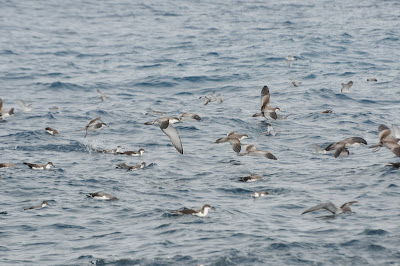
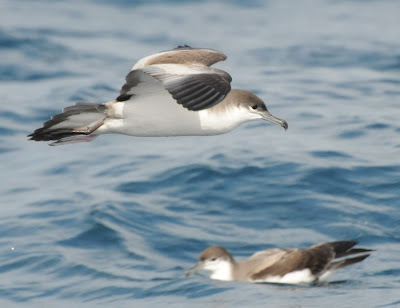




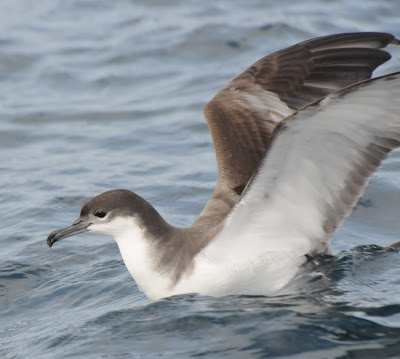




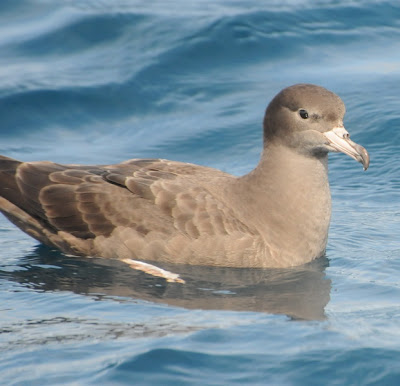
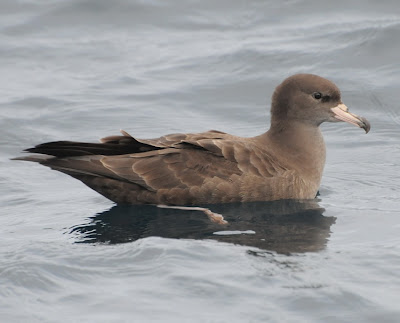



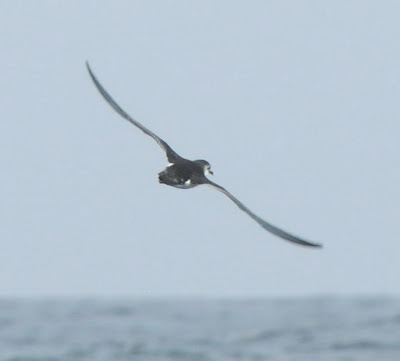

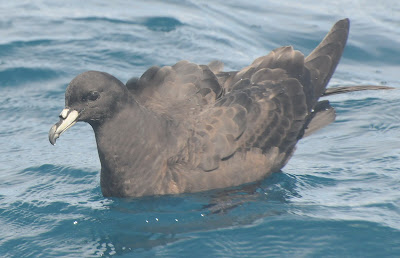




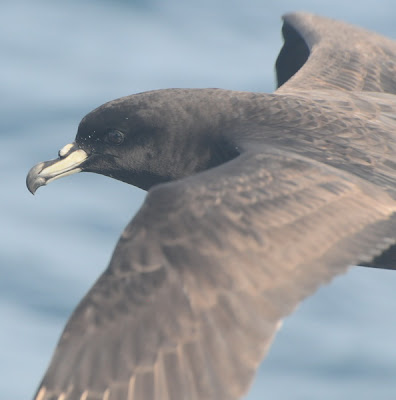

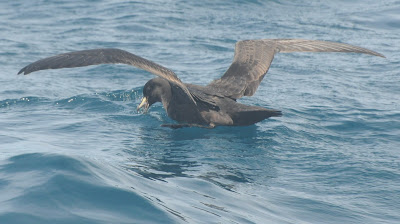










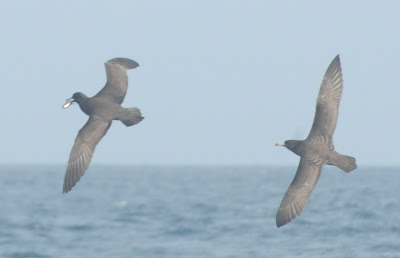

No comments:
Post a Comment